 W
WArmy Life; or, How Soldiers Are Made: Mounted Infantry is a 1900 British short black-and-white silent propaganda actuality film, directed by Robert W. Paul, featuring the King's Own Royal Lancaster Regiment riding over a plain. The film, which premiered on 18 September 1900 at the Alhambra Theatre in London, England, "is all that appears to remain of one of R.W. Paul's most ambitious projects," which, according to Micahael Brooke of BFI Screenonline, "had it survived in a more complete form," "would undoubtedly be considered one of the most important precursors of the modern documentary."
 W
WArtistic Creation is a 1901 British short silent comedy film, directed by Walter R. Booth, featuring a lightning sketch artist drawing a picture of a woman which comes to life piece by piece. The film, "is one of the earliest examples of a film about an artist's creations coming to life," and according to Michael Brooke of BFI Screenonline, "a metaphorical cautionary tale about the responsibilities that should be borne by both creative artists and indeed the male sex in general."
 W
WBetsy Ross is a surviving 1917 American silent historical film starring Alice Brady and produced and distributed by her father William A. Brady.
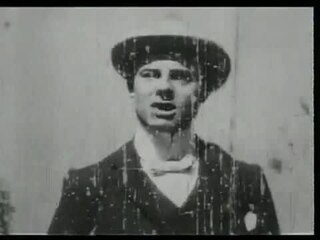 W
WThe Big Swallow is a 1901 British short silent comedy film, directed by James Williamson, featuring a man, irritated by the presence of a photographer, who solves his dilemma by swallowing him and his camera whole. The three-shot trick film is, according to Michael Brooke of BFI Screenonline, "one of the most important early British films in that it was one of the first to deliberately exploit the contrast between the eye of the camera and of the audience watching the final film".
 W
WCheese Mites, or Lilliputians in a London Restaurant is a 1901 British short silent comedy film, directed by Walter R. Booth, featuring a gentleman being entertained by the little people who emerge from the cheese at his table. The film, "contains a reference to Jonathan Swift's satirical novel Gulliver's Travels (1726)," and is, according to Michael Brooke of BFI Screenonline, "sophisticated in that he combined the jump-cut with superimposition."
 W
WThe Cheese Mites (1903) is a British short silent documentary film, produced by Charles Urban and directed by F. Martin Duncan.
 W
WA Chess Dispute is a 1903 British short black-and-white silent comedy film, directed by Robert W. Paul, featuring two gentlemen in a comedic fight following a disputed chess move. It is included on the BFI DVD R.W. Paul: The Collected Films 1895-1908.
 W
WThe Countryman and the Cinematograph is a 1901 British short silent comedy film, directed by Robert W. Paul, featuring a stereotypical yokel reacting to films projected onto a screen. The film, "is one of the earliest known examples of a film within a film," where, according to Michael Brooke of BFI Screenonline, "the audience reaction to that film is as important a part of the drama as the content of the film itself."
 W
WThe Death of Poor Joe is a 1901 British short silent drama film, directed by George Albert Smith, which features the director's wife Laura Bayley as Joe, a child street-sweeper who dies of disease on the street in the arms of a policeman. The film, which went on release in March 1901, takes its name from a famous photograph posed by Oscar Rejlander after an episode in Charles Dickens' 1853 novel Bleak House, and is the oldest known surviving film featuring a Dickens character. The film was discovered in 2012 by British Film Institute curator Bryony Dixon, after it was believed to have been lost since 1954. Until the discovery, the previous oldest known Dickens film was Scrooge, or, Marley's Ghost, released in November 1901.
 W
WExplosion of a Motor Car is a 1900 British short black-and-white silent comedy film, directed by Cecil M. Hepworth, featuring an exploding automobile scattering the body parts of its driver and passenger. "One of the most memorable of early British trick films" according to Michael Brooke of BFI Screenonline, "was one of the first films to play with the laws of physics for comic effect." It features one of the earliest known uses in a British film of the stop trick technique discovered by French filmmaker Georges Méliès in 1896, and also includes one of the earliest film uses of comedy delay – later to be widely used as a convention in animated films – where objects take much longer to fall to the ground than they would do in reality. It is included in the BFI DVD Early Cinema: Primitives and Pioneers and a clip is featured in Paul Merton's interactive guide to early British silent comedy How They Laughed on the BFI website.
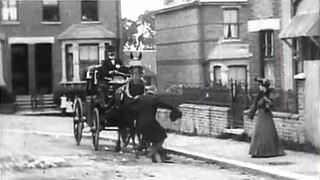 W
WAn Extraordinary Cab Accident is a 1903 British short silent comedy film, directed by Walter R. Booth, featuring a gentleman making a miraculous recovery after being trampled underfoot by a horse and cab. The film, "seems something of a step back," "compared with the elaborate special effects fantasies that director W.R. Booth and producer R.W. Paul had already concocted," but according to Michael Brooke of BFI Screenonline, "more complex special effects might well have worked against the impression Booth and Paul were clearly seeking to create, which is that of a man being genuinely run over by a horse-drawn cab, his body being knocked down and trampled by the horse's hooves."
 W
WThe Extraordinary Waiter is a 1902 British short silent comedy film, directed by Walter R. Booth, featuring a brutish colonialist failing to destroy a blackfaced waiter. The film, "makes for somewhat uncomfortable viewing," but according to Michael Brooke of BFI Screenonline, "it's just about possible to read this as a metaphor for the rather more widespread frustrations arising from British colonial rule, though it seems unlikely that this was intentional on Booth's part."
 W
WFlying the Foam and Some Fancy Diving is a 1906 British short silent comedy film, directed by James Williamson, featuring a man diving from Brighton Pier while mounted on a bicycle, in both forward and reverse motion. This trick film, according to Michael Brooke of BFI Screenonline, "adds additional layers of entertainment, firstly by showing the stunt from multiple angles and then by showing it in reverse motion so that Reddish appears to be performing the impossible feat of riding his bicycle vertically out of the sea". It is believed to be an extended version of Professor Reddish Performing his Celebrated Bicycle Dive from Brighton West Pier (1902), supplemented by more conventional footage of pier divers at a later date.
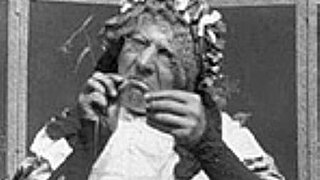 W
WGrandma Threading her Needle is a 1900 British short silent comedy film, directed by George Albert Smith, featuring a grandma trying to get a thread though a needle. The sole purpose of the single-shot film, like the director's earlier Old Man Drinking a Glass of Beer (1898), according to Michael Brooke of BFI Screenonline, "is to record changing facial expressions for the purposes of entertainment."
 W
WThe Haunted Curiosity Shop is a 1901 British short silent horror film, directed by Walter R. Booth, featuring an elderly curio dealer alarmed by various apparitions that appear in his shop. The film, "was clearly devised purely as a showcase for Booth and Paul's bag of tricks," and according to Michael Brooke of BFI Screenonline, "it's an effective and engrossing experience."
 W
WLa maison ensorcelée is a 1908 French short film directed by Segundo de Chomón. The film features stop-motion animation and is considered to be one of the earliest cinematic depictions of a haunted house premise.
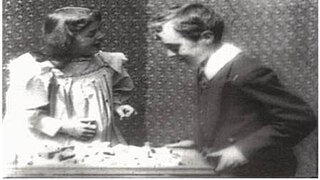 W
WThe House That Jack Built is a 1900 British short silent drama film, directed by George Albert Smith, featuring a boy who knocks over a house made of bricks built by his sister and then rebuilds it when the original sequence is shown in reverse. "In addition to exploiting a popular cinematic trick," of, "reversing the film in the projector," and, "its audience's presumed knowledge of the technique," the director, according to Michael Brooke of BFI Screenonline, "was continuing his experiments with narrative forms," with the reversed sequence, "interpreted as wish-fulfilment on the part of the girl, hoping that time will literally turn back on itself to allow her house to be rebuilt," he, "demonstrates that while this is impossible in reality, it is easily achievable in cinema."
 W
WAn Interesting Story is a 1904 British short silent comedy film, directed by James Williamson, showing a man so engrossed in his book he is dangerously oblivious to what happens around him.
 W
WLet Me Dream Again is a 1900 British short silent drama film, directed by George Albert Smith, featuring a man dreaming about an attractive young woman and then waking up next to his wife. The film stars Smith's real wife, Laura Bayley, as the woman of his fantasies. Bayley would later appear in Smith's 1906 film Mary Jane's Mishap. The film, according to Michael Brooke of BFI Screenonline, "is an excellent example of an early two-shot film, and is particularly interesting for the way it attempts a primitive dissolve by letting the first shot slip out of focus before cutting to the second shot, which starts off out of focus and gradually sharpens." This appears to be the first use of a dissolve transition to signify a movement of a dreaming state to one of reality.
 W
WThe Life of Moses is a 1909 American silent epic film directed by J. Stuart Blackton and starring Pat Hartigan, Julia Arthur and William J. Humphrey. A portrayal of the biblical story of Moses, it was one of a number of prestige film based on historical or religious subjects made during the era.
 W
WThe Little Match Seller is a 1902 British short silent drama film, directed by James Williamson, retelling the classic 1845 Hans Christian Andersen fable of the sad life and tragic death of a little match seller. This major fiction film of the period was, according to Michael Brooke of BFI Screenonline, "a serious attempt at depicting a person's inner emotional life on film through purely visual means, using trick effects not to provoke laughter but for serious dramatic reasons."
 W
WLiving Wigan is a 1902 short silent documentary film directed by James Kenyon and Sagar Mitchell, showing street life and a steam tram in Wigan town centre in August 1902. The film, which premiered in Wigan Town Hall before the Coronation celebrations of King Edward VII in 1902. It formed part of the two hour film show Live in Wigan. The tram featured in the film was run by Wigan Corporation Tramways.
 W
WThe Monster is a 1903 French short silent trick film directed by Georges Méliès.
 W
WMorecambe Church Lads' Brigade at Drill is a 1901 British short silent documentary film, directed by James Kenyon and Sagar Mitchell, showing the parade drill of the Morecambe Church Lads' Brigade on 3 July 1901. The film, which was premiered at the Winter Gardens in Morecambe on the same day it was filmed, was popular and went on to be shown at other venues in the North of England.
 W
WThe Old Maid's Valentine is a 1900 British short silent comedy film, directed by George Albert Smith, which features the titular Miss Pimple receiving an unpleasant surprise on 14 February. The film, according to Michael Brooke of BFI Screenonline, "is essentially a facial - a medium close-up shot of a single performer whose changing expression constitutes virtually all the film's dramatic action." David Fisher points out that, "the flapping of the sheet of paper and the movement of the calendar betray the open-air set," which, "makes it difficult to read the message: Just like Mama," whilst, "the remarkably well-behaved cat," which, "sits patently licking its paws," "suggests that Smith may have already learned the trick of smearing the cat's fur with food."
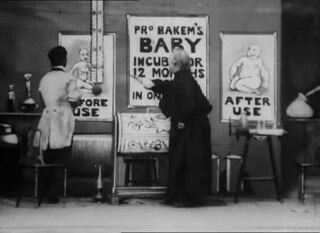 W
WAn Over-Incubated Baby is a 1901 British short silent comedy film, directed by Walter R. Booth, featuring a woman who gets an unpleasant surprise after placing her baby in Professor Bakem's baby incubator for 12 months growth in one hour. The film is, "one of the most original of the trick films made by W.R. Booth and R.W. Paul in 1901," and according to Michael Brooke of BFI Screenonline, "one of the less elaborate films made by Booth and Paul that year," "though the concept itself is so imaginative that it arguably didn't need any more than basic jump-cut transformations."
 W
WEl Satario, also known as El Sartorio, is the name of one of the earliest surviving pornographic films. It was supposedly produced in Argentina in 1907, and includes possibly the first use of extreme close-ups of genitalia. Others date it to 1930s Cuba.
 W
WThe Sealed Room is an eleven-minute film released in September 1909. Produced by the Biograph Company and directed by D. W. Griffith, the drama's cast includes Arthur V. Johnson, Marion Leonard, Henry B. Walthall, Mary Pickford, and Mack Sennett. It was distributed to theaters on a split-reel with another film, the three-minute comedy short The Little Darling.
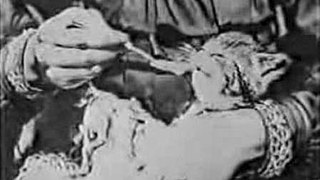 W
WThe Sick Kitten is a 1903 British short silent comedy film, directed by George Albert Smith, featuring two young children tending to a sick kitten.
 W
WSpiders on a Web is a 1900 British short silent documentary film, directed by George Albert Smith, featuring a single shot close-up of two spiders trapped in an enclosure. The film is, according to Michael Brooke of BFI Screenonline, "less formally ambitious," than the director's, "groundbreaking multiple close-up study Grandma's Reading Glass (1900), made the same year, but is nonetheless, "one of the earliest British examples of close-up natural history photography, predating Percy Smith's insect studies by a decade."
 W
WStenka Razin is the first finished Russian narrative film. The 10-minute silent film is a fictionalized account of episodes from the life of Stenka Razin. It premiered on 28 October [O.S. 15 October] 1908. Mikhail Ippolitov-Ivanov wrote a score for it.
 W
WStop Thief! is a 1901 British short silent drama film, directed by James Williamson, showing a tramp getting his comeuppance after stealing some meat from a butcher and his dogs. "One of the first true 'chase' films made not just in Britain but anywhere else", according to Michael Brooke of BFI Screenonline. It was released along with Fire! (1901), "indicating the direction Williamson would take over the next few years, as he refined this new film grammar to tell stories of unprecedented narrative and emotional sophistication."
 W
WTartans of Scottish Clans is a 1906 British short silent documentary film, directed by George Albert Smith as a test for his newly patented Kinemacolor system, which features a sequence of appropriately labelled Scottish tartan cloths, with an abundance of reds and greens, the two colours used by the system. The film, which was one of Smith's first Kinemacolor experiments, was according to Michael Brooke of BFI Screenonline, "a very simple idea which nonetheless demanded colour in order to convey the necessary information."
 W
WTo Demonstrate How Spiders Fly is a 1909 British short silent animated documentary film, directed by F. Percy Smith, featuring a close-up of an animated model spider throwing its silken thread to take to the air. The film features "the first of several animated creatures to appear in Smith's films", and according to Jenny Hammerton of BFI Screenonline was made in the belief, "that he could cure people of their fear of spiders by showing them blown up images of their eight legged foes on the cinema screen."
 W
WUndressing Extraordinary is a 1901 British short silent comedy film, directed by Walter R. Booth, featuring a tired traveller struggling to undress for bed. The film, "provides one of the earliest filmed examples of something that would become a staple of both visual comedy and Surrealist art: that of inanimate objects refusing to obey natural physical laws, usually to the detriment of the person encountering them," and according to Michael Brooke of BFI Screenonline, "has also been cited as a pioneering horror film," as, "the inability to complete an apparently simple task for reasons beyond one's control is one of the basic ingredients of a nightmare."
 W
WThe Waif and the Wizard, also entitled The Home Made Happy, is a 1901 British short silent comedy film, directed by Walter R. Booth, featuring a magician using his magic to aid an ailing girl at the request of her brother. The film, "is rather less elaborate in terms of special effects than the other films that W.R. Booth and R.W. Paul made the same year," but according to Michael Brooke of BFI Screenonline, "provides an excellent illustration of how effects used sparingly can often have more impact, especially when set in a suitable emotional context."
 W
WWillie's Magic Wand is a 1907 British short silent comedy film, directed by Walter R. Booth, featuring a young boy terrorising the household with his father's magic wand. Similar to "earlier trick films The Haunted Curiosity Shop and Undressing Extraordinary ," this is, according to Michael Brooke of BFI Screenonline, "essentially a series of [loosely linked] special-effects set pieces," however, "the print in the National Film and Television Archive is incomplete, omitting amongst other things a come-uppance where Willie is punished for his misdemeanours by being turned into a girl, thus depriving him of more than one magic wand." A clip from the film is featured in Paul Merton's interactive guide to early British silent comedy How They Laughed on the BFI website.
 W
WWoman Draped in Patterned Handkerchiefs is a 1908 British short silent documentary film, directed by George Albert Smith as a showcase of his new Kinemacolor system, which features a woman displaying assorted tartan cloths, both draped on her body and waved semaphore-style. The patterned handkerchiefs are, according to Michael Brooke of BFI Screenonline, "presumably the same cloths featured in Tartans of Scottish Clans (1906), this time shown from various angles."